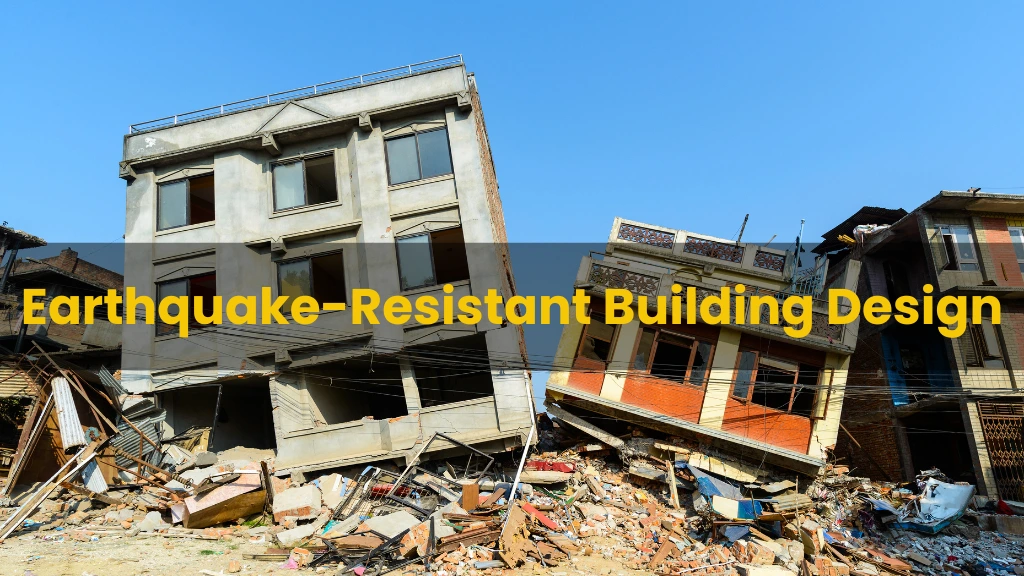Earthquake is one of the most catastrophic disasters that can lead to great loss with a huge impact on buildings, infrastructures and people. Techniques to be employed in construction projects in areas likely to experience the phenomenon must be in a position to withstand the impact of an earthquake to prevent the failure of buildings and infra-structures. Therefore, those structures are at a high risk, and the danger of collapse can be easily evidenced due to improper methods of engineering and construction methodologies.
Earthquake design is a method of constructing building / structures with the focused goal of making structures more safe to withstand the forces of earthquakes. Therefore, by incorporating principles of seismic design and advanced engineered solutions, architects and engineers can minimize loss and guarantee people’s safety.
Understanding Earthquake-Resistant Building Design
The seismic design of the structures encompasses the planning of buildings that would be capable of withstanding the impact of an earthquake. While normal structures crumble when subjected to an earthquake, the structures to be designed for an earthquake can sway safely during such an event.

Key Factors Influencing Earthquake Resistance
- Earthquake Structural Load – Structures require design that would enable them to stand the forces in the horizontal and vertical directions resulting from an earthquake.
- All these structures do not crumble under pressure since a flexible structure enables controlled movement.
- Foundation Strength – The adequate amount or strength of the foundation is crucial in reducing the likelihood of structure shifting.
- Material Selection – Reinforced concrete, structural steel, and shock-absorbing materials are more appropriate when it comes to performance issues of the building in an earthquake.
Seismic Design Principles for Earthquake-Resistant Buildings
Since engineers design buildings to be earthquake-resistant, certain seismic design principles enhance a building’s ability to endure ground motion.
1. Base Isolation Technology
- Such shock absorbers are base isolators that are placed between a building and its foundation.
- Instead, the isolators absorb this seismic energy, forcing less energy onto the building.
- Tokyo Skytree and San Francisco City Hall are examples of where it was used to hold up stability.
2. Ductile Structural Elements
- Bending a material without it breaking is ductility.
- Buildings are supposed to use reinforced concrete, steel frames, and shear walls and this is to allow for controlled movement.
- Soft-story (or open ground floor) buildings should be reinforced to resist collapse.
3. Shear Walls and Cross Bracing
- Vertical elements that absorb forces from seismic action and distribute them are called shear walls.
- Lateral strength is increased by cross bracing but lowers excessive swaying.
- Burj Khalifa in Dubai is a good example of a building that absorbs seismic shocks through high-performance shear walls.
4. Moment-Resisting Frames
- Because of these frames, controlled bending can be imparted without structural failure.
- To resist high stress, the beams and columns are connected.
- Example: Used in high-rise buildings in earthquake-prone areas.
5. Energy Dissipation Systems (Dampers)
Seismic energy is transmitted less and excessive motion is avoided with the use of dampers.
Types of Dampers:
- Energy Absorb ‘Viscous Dampers’: Absorb the energy using fluid.
- Skyscraper oscillations can be reduced with the help of Tuned Mass Dampers.
- Seismic Energy to Heat Convertor: Conversion of seismic energy to heat.
- In particular, for example: the Taipei 101 skyscraper has a 660-ton tuned mass damper for stability.
Construction Techniques for Earthquake-Resistant Buildings
1. Strong Foundation Systems
- Earthquake-resistant foundations that extend deep into the ground such as piles and piers sweep seismic forces across large areas.
- The installation of rafts creates foundations that enhance stability during conditions of poor ground soil.
2. Lightweight and Flexible Materials
- High seismic resistance can be found in structural steel along with reinforced concrete.
- The performance of wood-frame buildings with flexible frames is optimal when used in moderate seismic regions.
3. Reinforced Masonry & Seismic Retrofitting
- Building structures without additional reinforcement measures makes masonry buildings extremely susceptible to breaking in earthquakes.
- A seismic retrofit procedure includes strengthening older structures by using the following elements:
- Steel bracing
- Fiber-reinforced polymers (FRP)
- External reinforcement layers
4. Symmetrical and Regular Building Design
- Seismic forces become more intense at both weak points that result from buildings with irregular shapes.
- The distribution of structural mass along with stiffness works toward reducing the chance of structural failure.
5. Proper Roof and Floor Connections
- Proper connections between roofs and floors with walls are necessary to prevent building failure.
- The structural integrity benefits from tie beams as well as diaphragms.
Earthquake Building Codes and Global Standards
Earthquake Building Code is indeed implemented in different countries to control construction in areas that are vulnerable to earthquakes. This is to proffer concrete solutions to new emergent and long-held social issues that the following recognized standards illustrate:
1. National Building Code of India (NBC 2016)
- Establishes seismic zones and code of practices that should be adhered to while constructing any building.
- Divides India into Zone II (low risk) to Zone V (highest risk).
2. American Society of Civil Engineers (ASCE 7-16) – USA
- Gives provisions on the permissible seismic loads in buildings.
- Open source: This is beneficial in the design of skyscrapers and important infrastructures such as bridges.
3. Eurocode 8 – Europe
- Covers earthquake-resistant construction across European Union countries.
- Emphasis is put on: Structural reinforcement, bridges, and retrofitting of existing structures.
4. Japanese Building Code (JBC 2000)
- Since Japan is a region that is prone to earthquakes, the nation has very stringent seismic code requirements.
- It is required that buildings be subjected to shake tests before being commissioned.
5. International Building Code (IBC 2021)
- Republican regulations provide fire safety measures in residential buildings and structural safety in seismic zones.
- This was distinctive for including guidelines for the foundation considerations, used materials, and damping systems.
Conclusion
Earthquake frequency increases and therefore earthquake-proof building designs are essential for avoiding loss of lives and property. It has become important to follow seismic design principles along with the techniques of construction as well as international building codes for safe and reliable construction.
That is why, governments, engineers, and developers should pay much attention to the issue of seismic safety in any construction. If you reside in an area that is vulnerable to earthquakes, you should do some retrofitting which will help strengthen your house or place of business.
Read More: Ready-Mix Concrete (RMC) vs. On-Site Mixing: Which One is Best for Your Construction Project?
FAQs
1. Which material produces the most effective buildings during earthquakes?
Three earthquake-fighting materials include reinforced concrete, and structural steel together with engineered wood.
2. What mechanisms allow base isolators to perform their role during earthquakes for structural design purposes?
The installation of base isolators enables this system to absorb ground motion which ultimately blocks force transmission between the building and the earth and thereby decreases building damage.
3. What design factor makes symmetrical buildings perform better during earthquakes?
Symmetrically-designed buildings use balanced seismic force distribution to decrease structural risks and maximize their stability during earthquakes.
4. What is seismic retrofitting?
By adding bracing and dampers and reinforcing masonry buildings with bracing practitioners enhance older structures to endure earthquakes more effectively.
5. What countries implement the harshest rules regarding earthquake building compliance?
Japan together with the United States and Chile enforce among the strictest earthquake-related building regulations which preserve building safety standards at high levels.









I always was interested in this topic and still am, appreciate it for posting.